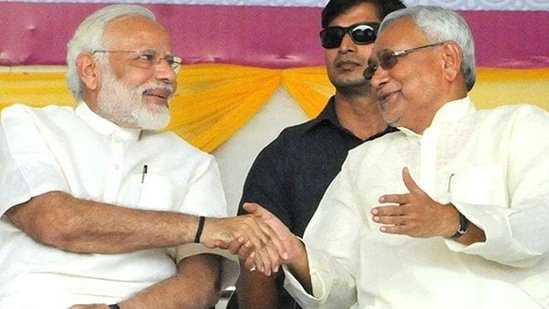Bihar politics: Why did Nitish Kumar leave NDA and form government with RJD in 2022?

Nitish Kumar of the Janata Dal (United) on Sunday resigned as the chief minister of Bihar and staked claim to form a new government with the Bharatiya Janata Party, which he had dumped less than 18 months ago.
Nitish Kumar had joined the Mahagathbandhan or grand alliance in August 2022, when he had snapped ties with the BJP accusing it of trying to “split” his JD(U). He formed a new government with a multi-party coalition that included Lalu Prasad Yadav/Tejashwi Yadav-led Rashtriya Janata Dal, Congress and three Left parties.
On Sunday, January 28, Nitish Kumar alleged that he broke away from the grand alliance as "things were not working well" for him in the Mahagathbandhan and the opposition bloc INDIA.
The JD(U) has 45 members in the 243-member Bihar assembly, while the BJP and other NDA allies have 82. A party or a grouping needs 122 lawmakers to form the government. The RJD, Congress, and Left parties have 114 lawmakers. The RJD is the single largest party in the House with 79 lawmakers.
Why did Nitish Kumar dump NDA?
The JD(U), once the senior partner in Bihar's NDA, faced a decline, trailing behind junior ally BJP. Nitish Kumar grew discontented with the BJP, blaming them for the drastic drop in his party's assembly seats from 71 in 2015 to 43 in 2020, while the BJP's count rose from 53 to 74, second only to RJD's 75.
Nitish Kumar reportedly blamed the BJP for influencing Lok Janshakti Party (LJP) leader Chirag Paswan to field candidates in nearly all constituencies where JD(U) was contesting.
Nitish Kumar also reportedly felt uneasy with deputy chief ministers Renu Devi and Tarkishore Prasad, lacking the rapport he shared with Sushil Kumar Modi, who served as deputy CM for 13 years.
Why is Nitish Kumar returning to NDA now?
Nitish Kumar, 72, indicated that he was not feeling happy with the way things were in the Mahagathbandhan in Bihar as well as the INDIA bloc that he helped take shape but which failed to adequately recognise his efforts.
“You all know how I came to this alliance and also how I worked to bring together so many parties. But of late things were not working well. It was not going down well with those in my party as well,” Nitish Kumar told reporters on Sunday.
Nitish Kumar also made an indirect reference to the deafening silence he had maintained over the political turmoil that had engulfed the state for the past few days.
He resigned after a meeting of the JD(U) legislature party, which authorised him to take any decision about the alliance.
According to the Raj Bhavan, Nitish Kumar has been asked to continue as caretaker chief minister till the formation of a new government.
After his breakup with the BJP in 2013, Nitish Kumar still survived in power as the JD(U), which was then just a few members short of the majority mark, got outside support from parties like the Congress and CPI, besides a disgruntled faction of the RJD. A year later, though, he resigned owing moral responsibility for the JD(U)’s drubbing in Lok Sabha elections.
In less than a year, Nitish Kumar was back as chief minister, elbowing out his rebellious protégé Jitan Ram Manjhi, this time armed with ample support from the RJD and the Congress.
The grand alliance that came into being with the JD(U), Congress and RJD coming together, won the 2015 assembly elections handsomely but came apart in just two years. Nitish Kumar returned to the NDA in 2017, hoping to get some traction after taking a stand against corruption taint on his then deputy Tejashwi Yadav.
Five years later, Nitish Kumar again grew disillusioned with the BJP, blaming it for the JD(U)’s debacle in the assembly polls of 2020, when Chirag Paswan fielded many BJP rebels on tickets of his Lok Janshakti Party.
By August 2022, he was back in the Mahagathbandhan or grand alliance, which now also included three Left parties.
Although he retained his chair, NitisKumar indicated that he had his fill and wanted to mentor Tejashwi Yadav, back as his deputy, as his political successor in the state while applying himself with great vigour to bring together all political outfits opposed to the BJP, hoping for a Janata Party-like formation which could, like the post-Emergency polls, pull off a victory against a seemingly invincible regime.
As host of the first meeting of such like-minded parties, held in Patna last year, he was widely regarded as the architect of the opposition front INDIA which, however, baulked at naming him as its convenor, and irked him with suggestions like projecting the elderly Congress president Mallikarjun Kharge as the prime ministerial candidate, news agency PTI reported.
Nitish Kumar had also been greatly miffed by the delay in seat-sharing arrangements and the inability of the constituents of the united front to sort out differences, as was evident in West Bengal and Punjab.
Culled from Hindustan Times

